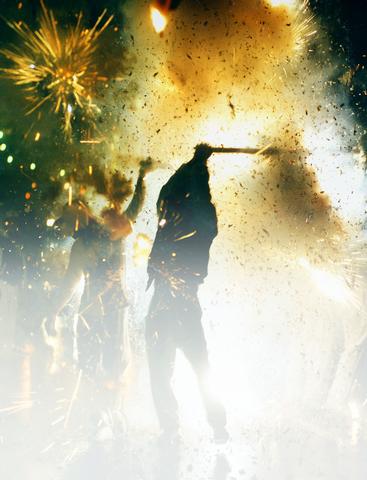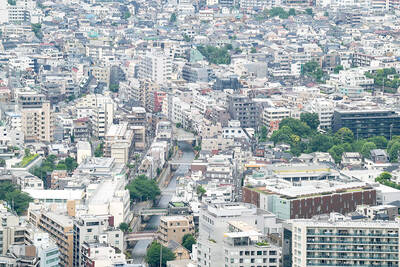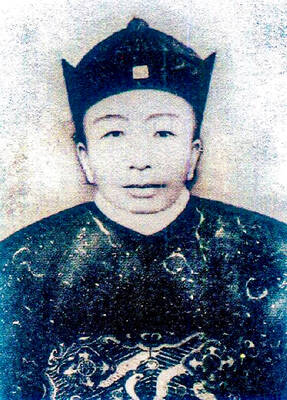An audio-visual spectacular held fifteen days after each Lunar New Year, the Yenshui Fireworks Festival (鹽水蜂炮) is one of the most exciting cultural events in the world. The festival, which reenacts a nineteenth-century plague expulsion ritual, draws tens of thousands of people to the small Tainan County town of Yenshui.
Many people consider the activity -- in which fireworks are fired above, around and into the vast audience -- to be pointlessly reckless. Enthusiasts, however, regard being hit by these projectiles as auspicious, and describe the pandemonium as exhilarating.

TAIPEI TIMES FILE PHOTO
Participation is free; all costs are met by local businesses and temples.
Between dusk Tuesday Feb. 26 and dawn Wednesday, effigies of Kuankung, the god of war, will be paraded in palanquins around Yenshui, carried over burning piles of spirit money, and, at various points along the route, set down before "rocket hives."
The festival is ostensibly in honor of Kuankung, but it is these "hives" -- pyrotechnic launch platforms the size of shipping containers -- which are the center of attention. Each structure bristles with heavy-caliber launch tubes and racks chock-full of bottle rockets -- up to 20,000 projectiles in each.
Once the palanquins are in place, technicians tear off the red paper covers and trigger the contents.
What happens next is akin to standing near an ammunition dump on which the enemy has just scored a direct hit.
Each engagement begins with a dazzling vertical fusillade. Then, over the course of a minute or so, the angle of fire sinks. Fireworks shoot like tracer bullets over the heads of those nearby before bombarding both the palanquins and the audience. For the final few seconds screeching rockets skid up off the road surface, bruising shins and knuckles.
Coinciding with but unrelated to the Lantern Festival, the Fireworks Festival has its origins in a cholera epidemic which wreaked havoc on Yenshui more than a hundred years ago. To drive out the evil spirits they blamed for the outbreak, townsfolk carried a statue of Kuankung through the streets while letting off masses of firecrackers. The epidemic soon receded. Ever since there has been an annual reenactment of the plague expulsion parade.
Some local businesses barricade themselves shut for the duration. But for others the event is a bonanza. "I like the Fireworks Festival because lots of people come here. Its very exciting. And if the event falls on a Saturday or Sunday, its very good for business," said Su Hsiu-juan (
Given the congestion and air pollution which the festival generates, it is not surprising that some locals want the event scrapped altogether. "Yenshui people are stupid. They spend so much money on fireworks, and then they need to clear up the garbage afterwards," said one businessman who asked not to be named.
There seems to be little organized opposition to the Fireworks Festival, however.
According to Chinese-language media reports, in recent years, between 80 and 100 people have been injured at each festival -- many by fireworks, some crushed in the tumult. Anecdotal evidence suggests the true number of casualties could be significantly higher. During a typical festival, Yen Chia-hsiung (顏佳雄), a local drugstore proprietor, gives first aid to 10 or more individuals.
"I've seen ear, eye, chest and leg injuries, plus people whose hair caught fire," he said.
Some people with relatively serious burns have come to Yen for ointment and bandages, and then gone home -- or rejoined the festival.
Even well-prepared individuals can get hurt, as Ariana Lindquist, a Taipei-based English teacher, discovered to her cost two years ago. "My friend and I had decided to head home, so I took my ear plugs out," said the Minnesotan. "Then we went back and stood right in front of a fireworks wall as it went off. A rocket flew up under my helmet and exploded. It took a month for the hearing in one of my ears to fully recover."
Undoubtedly the safest and most comfortable way to enjoy Yenshui's Fireworks Festival is to watch it from a downtown balcony or rooftop. But for outsiders, even those willing to pay, this is difficult to arrange. Many landlords worry strangers might damage their property, and so restrict access to friends and relatives.
In any case, veterans agree, viewing is no match for ground-level participation. This requires stamina and preparation.
Some join the parade carrying only a large sheet of cardboard or plastic with which to defend themselves -- scant protection against ricocheting projectiles.
A full-face motorcycle helmet with a strong visor is essential, while those who expect to be in the thick of it should leave no flesh exposed. A towel used as a scarf makes for good neck protection.
Old clothing is preferable. Rockets sometimes catch in the folds and set the material alight, while flying embers burn tiny holes in almost everything.
On the night, vendors sell protective headgear, smog masks, ear plugs and other useful items. It is best to arrive fully prepared, however, as these products are often shoddy or ill-fitting.
Footwear should be the strongest possible. Following the parade entails a great deal of walking. Toes get trampled in the mayhem.
There are other hazards. The smoke causes sore throats. Pickpockets work the crowds.
On festival night police stop non-residents from bringing vehicles into the town.
Fortunately, Yenshui is easy to reach by public transportation. Express trains stop at nearby Hsinying, from where visitors can take a taxi or local bus.
Visitors leaving late at night will find plenty of taxis, and private bus companies offering rides to Taipei and Kaohsiung.
Those who find crowds claustrophobic, or dislike standing for long periods, are better off staying at home -- or attending the more sedate fireworks competition at Luerhmen, a temple complex in Tainan City.
But for aficionados of unusual and memorable experiences, the Yenshui Fireworks Festival provides a rush that few will forget.

The canonical shot of an East Asian city is a night skyline studded with towering apartment and office buildings, bright with neon and plastic signage, a landscape of energy and modernity. Another classic image is the same city seen from above, in which identical apartment towers march across the city, spilling out over nearby geography, like stylized soldiers colonizing new territory in a board game. Densely populated dynamic conurbations of money, technological innovation and convenience, it is hard to see the cities of East Asia as what they truly are: necropolises. Why is this? The East Asian development model, with

June 16 to June 22 The following flyer appeared on the streets of Hsinchu on June 12, 1895: “Taipei has already fallen to the Japanese barbarians, who have brought great misery to our land and people. We heard that the Japanese occupiers will tax our gardens, our houses, our bodies, and even our chickens, dogs, cows and pigs. They wear their hair wild, carve their teeth, tattoo their foreheads, wear strange clothes and speak a strange language. How can we be ruled by such people?” Posted by civilian militia leader Wu Tang-hsing (吳湯興), it was a call to arms to retake

Desperate dads meet in car parks to exchange packets; exhausted parents slip it into their kids’ drinks; families wait months for prescriptions buy it “off label.” But is it worth the risk? “The first time I gave him a gummy, I thought, ‘Oh my God, have I killed him?’ He just passed out in front of the TV. That never happens.” Jen remembers giving her son, David, six, melatonin to help him sleep. She got them from a friend, a pediatrician who gave them to her own child. “It was sort of hilarious. She had half a tub of gummies,

The wide-screen spectacle of Formula One gets a gleaming, rip-roaring workout in Joseph Kosinski’s F1, a fine-tuned machine of a movie that, in its most riveting racing scenes, approaches a kind of high-speed splendor. Kosinski, who last endeavored to put moviegoers in the seat of a fighter jet in Top Gun: Maverick, has moved to the open cockpits of Formula One with much the same affection, if not outright need, for speed. A lot of the same team is back. Jerry Bruckheimer produces. Ehren Kruger, a co-writer on Maverick, takes sole credit here. Hans Zimmer, a co-composer previously, supplies the thumping